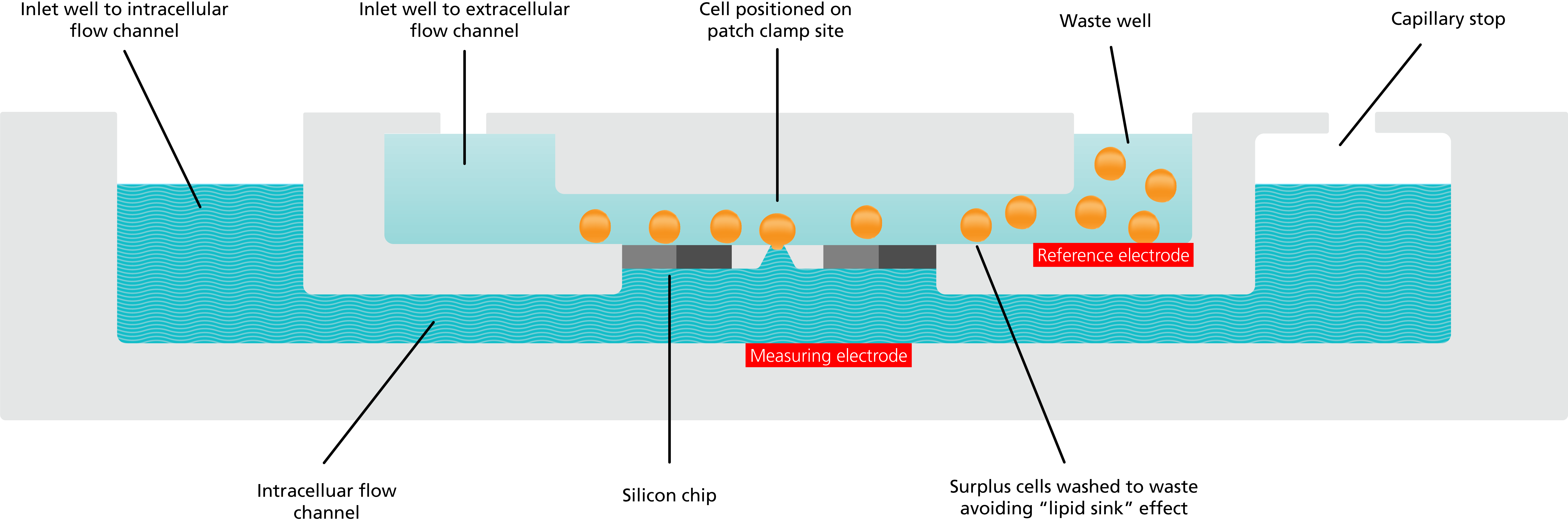Unique QPlates with integrated and maintenance free electrodes for QPatch Compact & QPatch
QPlates are uniquely designed for use with QPatch Compact and QPatch. The integrated flow channels and maintenance-free integrated electrodes provides a non-compromised test environment and ensures consistent quality recordings time after time.
Dual electrodes integrated in each measurement site on the QPlate eliminates the need for electrode maintenance and the risk of electrode drift. Thereby, ensuring consistent and high-quality data recordings. Furthermore, the silicon chip substrate allows for true gigaohm seal recordings in physiological EC/IC solutions without the need for seal enhancers, which makes QPlates ideal for cardiac safety studies and stem cell research.
QPlates offer:
- Giga-Ω seal in physiological solutions – no need for seal enhancers, or fluoride
- Glass coated to minimize compound adsorption
- Microflow-based to ensure 100% liquid exchange
- Two embedded electrodes per well eliminate the risk of electrode drift and eliminate the need for electrode maintenance (re-chloridization)
- Single- and multi-hole recordings
- Current clamp recordings, as well as voltage- and ligand-gated
Choose your QPlate depending on your needs:
- QPlate 8/16/48 – single-hole per measurement site
- QPlate 8X/16X/48X – 10-hole per measurement site
- QPlate custom – varying hole sizes and number of holes
The QPlate is ideal for high performance measurements both ligand-gated and voltage-gated ion channel patch clamp

QPlates and QChips are both microflow-channel based (liquid displacement method), ensuring 100% compound exchange without risk of 'overshoot concentrations' that can happen using open well technology (liquid dilution method). Both QPlates and QChips has two embedded electrodes eliminating the risk of electrode drift and eliminates the need for maintenance (re-chloridization) that takes up precious instrument uptime.
QPlates are designed with microfluidic flow channels that deliver compounds and buffers to the intra- and extracellular part of the cell. This enables a series of liquid additions to be applied sequentially to the same cell, thus increasing throughput, and reducing cost per data point.
The microflow channel technology also means that compound trays are prepared in the correct concentrations and no dilution of compounds takes place (liquid displacement method). This has the advantage that no ‘overshoot’ concentrations will happen as can be seen using the open well technology (liquid dilution method). Using the dilution method an excess concentration of compounds is added to the wells since the compound will be diluted in the liquid already in the well.
QPlates are available in both single- and multi-hole versions. In addition, different sizes and numbers of holes (for the multi-hole QPlates) are available on request. You can use the full QPlate in one assay, or use one or more columns on the QPlate per assay depending on what is most suitable for your experiment.



